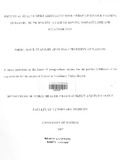| dc.description.abstract | The high rate of urbanization following rural-urban migration and natural population growth has
led to increased food demands, more than the rural production systems can handle. The high
population has also led to an acute shortage in employment especially in the formal sector. As
one of the coping strategies, the urban dwellers have opted to agriculture, which involves both
crop and animal production. Despite the benefits associated with urban and peri-urban
agriculture, there are risks such as zoonotic disease infection (bacterial, viral, parasitic and
protozoal), associated with the practice. These endanger not only the lives of the farmers but also
the public in general.
In this study, focused group discussions (FGD) and household survey were carried out to assess
knowledge, attitude and farmers' perception on health hazards associated with urban livestock
farming in Nakuru Municipality. The single comparative intradermal tuberculin test (SCITT)
was performed or: 97 heads of cattle to determine the apparent prevalence of bovine tuberculosis
(BTB) and 117 milk samples collected for detection of aflatoxin Ml in milk using the Charm
Sciences (USA) Aflatoxin Test kit. Cattle were the main livestock kept in majority 83 % (n=202)
of the sampled households followed by poultry.
NAIROBI U '\1r~Srrr
E. E. U8RASY
The most important benefits of rearing livestock identified included livestock as a source of
employment, income, nutrition, security and provision of manure. There were gender difference
in ranking and scoring of the major benefits in the various study sites.
Generally, the farmers had limited knowledge on the risks associated with livestock keeping. The
only zoonotic conditions participants in the FGD could associate with livestock keeping were
rabies and brucellosis. When asked to prioritize diseases in order of importance, 46.6% of the
XIV
respondents gave brucellosis the first priority, 14.7% anthrax, 8.6% intestinal worms and 4.3%
bovine tuberculosis (BTB). Seven percent could not associate any disease with urban livestock
keeping.
Thirty four percent of the respondents in the household survey were aware that cattle could be
infected with Mycobacterium bovis and 67% could associate raw/inadequately cooked or boiled
milk and meat with BTB. Responding to the question on the precautions taken against BTB
infection, most of the farmers either did not know or did not take any.
Results from FGDs and corroborated by the household study showed that farmers were generally
aware of aflatoxin poisoning in humans. None of the participants in the FGD had heard of the
condition in animals while 18% from the household survey were aware animals could pass the
toxin to human. Only a few participants in the FGD and 58% of the respondents in the household
survey could associate the condition in human to consumption of incompletely dried/moldy
maize. Sixty eight percent of the respondents in the household survey either did not take or did
not know of any precautionary measure against aflatoxin poisoning.
Seventeen of the 97 heads of cattle reacted positive to the tuberculin test giving an individual
animal apparent prevalence of 17.5%. Six of the 117 milk samples (5.1 %) tested positive to
AFM 1 residues.
With the limited knowledge of the study population and with the presence of BTB reactors in the
animal population and AFM I in milk, it was concluded that there is need to educate the farmers
and the general public on the health hazards associated with livestock keeping. There is need to
review the BTB status in the country and establish the significance of /vfbovis in the rising
incidence of human tuberculosis. Presence of AFMI in milk warrants closer inspection of animal
feeds, through surveillance and control of feed quality during feed processing and distribution. | en |

